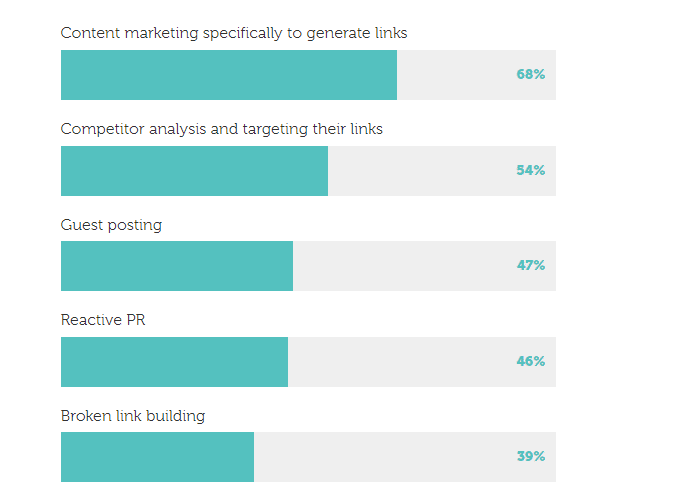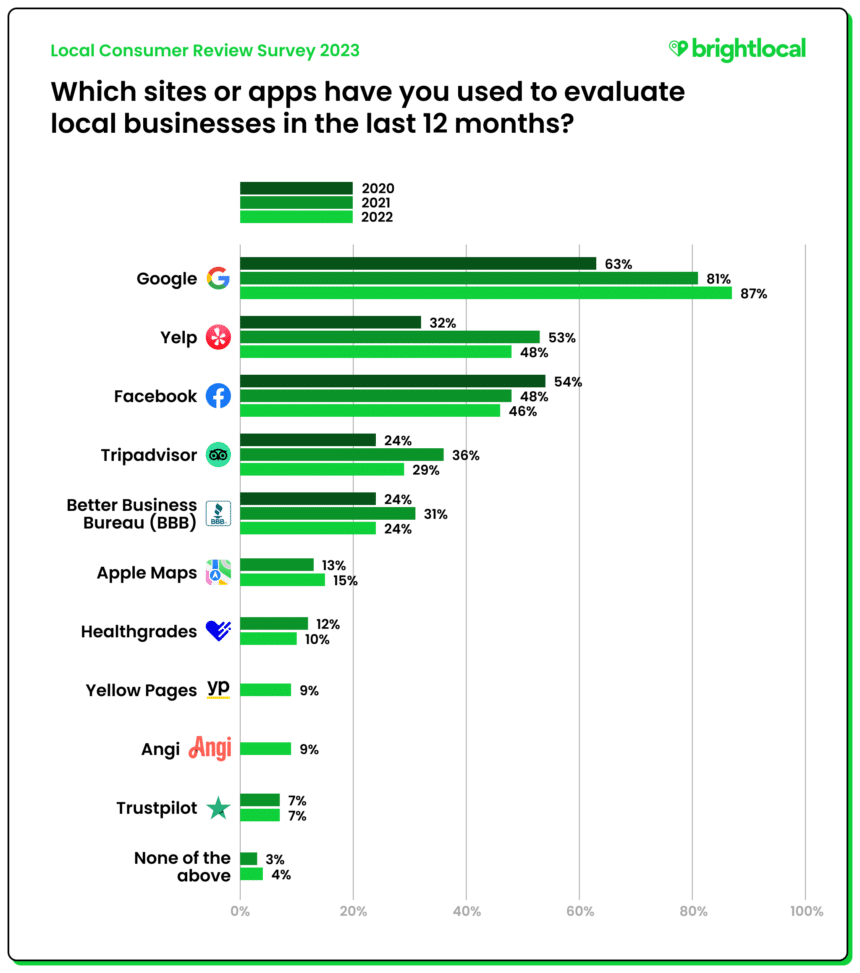The SaaS landscape is extremely competitive regardless of your exact niche. Building a SaaS business is relatively simple which is why we’re seeing an abundance of SaaS startups. With that kind of competition, SaaS businesses must take advantage of every opportunity to stand apart. That’s where link building comes in. An effective link building strategy can help SaaS companies improve their SERP rankings, drive traffic to the website, and increase brand visibility and engagement.
In this article, we will discuss 20 link building strategies for SaaS companies and how to select the right strategy for your SaaS business.
Link Building Strategies for SaaS Companies
1. Build Linkable Assets
Regardless of the niche, having a blog is vital for all SaaS businesses. It’s where the business delivers value to its customers, educates them, and establishes itself as a domain expert. It allows businesses to connect and engage with their audiences and let them know they exist.
Having a blog is about more than just sharing information. It should also have a great UI (user interface) and UX (user experience), and the content needs to be top-notch. No one wants to send their audience to someplace below average. Quality content attracts quality backlinks. If you want backlinks that add value, then add value to your reader by investing time and energy into building unique and insightful content.
2. Guest Posting
Guest posting is a very popular and widely-used SaaS link building strategy. The premise of quest posting is pretty simple. You reach out to companies and blogs that publish content and ask if they would like free high-quality content for their site.
Once they accept your proposal and the topic, your content team works on creating high-quality content and includes a backlink naturally to a page where you want to build authority and increase organic traffic.
While it’s a great way to amass backlinks, guest posting may seem like a lot of effort. However, it pays for itself in domain authority and organic traffic over time. When it comes to SEO specifically link building, you cannot expect results overnight.
3. Unlinked Brand Mentions
Brand mentions are a great way to make use of companies that already mention you in their content. It’s particularly beneficial for SaaS companies in competitive industries where building credibility and authority is challenging. To leverage brand mentions for SaaS link building, companies can use tools like Google Alerts or Mention to monitor online mentions of their brand. Once they spot a mention, they can reach out to the website owner or author and request a link to their website.
The best way to capitalize on brand mentions is through unlinked brand mentions. To leverage those, SaaS companies can reach out to websites that mention your brand but don’t include a link. The best way to find those brands is by setting up a Google News alert and checking which website mentioned you and whether they included a link.
4. Linked Brand Mentions
While linked brand mentions may not get you new links, they’re still a great way to get valuable backlinks. To win higher-quality links, negotiate with websites that have linked to your homepage and ask them to link to a more relevant page so you can capitalize on higher-quality links. Links that are more relevant are considered high-quality and are more beneficial to a website.
5. SaaS Product Embeds
Product embeds are a unique opportunity that only SaaS companies can utilize. Also known as widget link building, SaaS product embeds are a great way to get backlinks without looking for prospects.
Product embeds are created when your users embed part of your SaaS product on their own websites. For example, when you embed a Google form on your website, they also include a link that goes back to their website, which in turn, boosts your website rankings.
To leverage SaaS product embeds, all you need to do is find a way to make your product embeddable and include a ‘Powered By’ link back to the relevant page on your website.
6. Roundups
Every one of us has come across articles like “30 Productivity Tips from Experts’ and “20 SEO Tools that Come Highly Recommended”. Everyone loves to hear what experts and seasoned professionals have to say and when you create content by interviewing these experts, there’s a high chance that you will get tons of backlinks.
You don’t have to have a spot when a roundup is originally published. Rather you can reach out to the website or blog and ask to be included in the roundup. If you’re commendable, then there’s a decent chance of you being included in the roundup.
Here’s how you can secure a link to a roundup. Search for credible blogs and websites in your niche that regularly post relevant round-ups and make a list. Next, reach out to each publication and present your SaaS product and ask to be featured in an upcoming or current round-up on their website.
7. Broken Links
An out-of-the-ordinary, but interesting way to link building is the broken link tactic. According to Aira’s Annual State of link building Report, broken link building is the fifth most widely used link building tactic.

In broken link building, you look for websites with broken links within your target niche and ask the site owner to link to your content instead. Broken links originate when a website removes an article or blog that was previously linked to a website, but this tactic can be used with certain nofollow links if you’re willing to get creative.
You can use Broken Link Checker tools to find broken links. It should be noted that broken link building tactics can be tardy if you’re creating new content from scratch.
8. Podcasting
Connecting podcasting with link building sounds weird. I mean, how can you expect search engines to find your website from a podcast?
You may be surprised to know that podcasts aren’t just a great way to reach your ideal customer profile (ICP) but they’re also great for link building. Here’s how. Most podcasts are uploaded on a website, so when someone speaks on a podcast, they usually include links back to the websites that they mention.
What makes podcasting so great is that you don’t have to go out of the way to find quality links. All you need to do is do some prep and talk for an hour or a half on a subject that you’re already familiar with. It’s a unique opportunity for SaaS companies to get backlinks with little to no effort.
9. Infographics
Who doesn’t love infographics? Personally, I would rather skim through content or read highlights than read long-form articles. Regardless of your exact niche, infographics are a great way to make content engaging and credible. This is why using infographics to get backlinks is ingenious.
To use this tactic, reach out to other companies with blogs that can use infographics. Just tell the website owner how mutually beneficial it could be if you provide them with the infographics and they mention you and include a link back to your website.
10. Image Credit
No matter how unique and amazing your content is, it seems bland and incomplete without images. If you often add custom images to your website, then there’s a high chance that another website is using that image without giving credit.
The image credit strategy works similarly to brand mentions where you reach out to websites that are using your content but not giving credit. Most websites will gladly comply to keep the image or they might remove it. Either way, it’s worth a shot.
11. Product Review
If you want to kill two birds with one stone, then start using product reviews to your advantage. According to the Local Consumer Review Survey, almost 98% of consumers read online reviews when researching local businesses and use platforms like Google, Yelp, and Facebook.

What makes product reviews a great way to get links is that you can also get potential customers since you’re marketing the product. Since people love free products, it’s a great way to get backlinks. Plus who knows if they get so impressed by the product that they become long-term paying customers afterward.
The product review strategy involves reaching out to bloggers in your niche and offering your SaaS product for free for a few months in exchange for a review. Don’t forget to leverage influencers on social media to get reviews and market your product on various social media platforms as well.
12. Help a Reporter Out (HARO)
A great way to find regular link building opportunities is through HARO. It’s a website that connects journalists and reporters with industry experts.
The sign-up process is pretty simple but requires time and effort over time. Start by signing up for their daily email to find requests that fall within your expertise. For example, if your SaaS product revolves around data security, then you can reach out to the journalist or reporter and offer your expertise in exchange. If the reporter reaches out and adds your quote in their article, then it will appear with your name and a link to your website.
HARO is useful because it’s not just free but also a permanent source of opportunities. SaaS brands have previously used this tactic to get links from websites like Forbes and Inc.com. While HARO is one of the most popular platforms in the roundups game, it’s certainly not the only one. Here are a few more places where you can find similar opportunities:
- Source Bottle
- OnePitch
- Qwoted
- Terkel
13. Integration Partners
As most of the workforce is moving towards remote work, SaaS companies need to extend their usability by allowing users to access their apps from another platform. That’s where integrations come in.
Integration partnership offers two SaaS companies to work together for mutual benefit. They can promote each other’s products and services, and gain more traffic and backlinks. Generally, you will get at least two backlinks, one from their blog post and another from their help documentation.
14. Free Tools
Who doesn’t love freebies? Free tools are a great way for SaaS companies to attract their ideal customer profile and increase product signups. You’re bound to see results if the tool brings real value to the user. To use this strategy for link building, you will not only need to build a free tool but also promote it to relevant communities.
15. Testimonials
Whether you’re buying a shampoo or subscription to a magazine, recommendations and testimonials play a key role. Most SaaS companies will appreciate a testimonial from another credible name. We’ve all seen reviews and testimonials for products and their effect on the consumers. While most platforms only give you a nofollow link, it’s still worth a try. Start by making a list of products or services that you recently used, and reach out to them. Tell them you’ll give a testimonial in exchange for a link back to your website.
16. Conferences and Webinars
Sponsoring or speaking at a conference can be a great link building strategy and a way to build thought leadership. There are all kinds of online and offline conferences that are looking for speakers with the same skill set and portfolio as someone in your organization. Just make sure that when you speak at a conference, they mention and link back to your website.
17. Backlinks from Community Sites
Do you know where people go when they can’t find an answer? A community platform or a Q&A site like Quora, Reddit, or Yahoo! The process is as simple as going to a Q&A site and searching for questions relevant to the problems that your SaaS product is solving. Mention your product and give a detailed answer on how your product can help and link back to your website.
The best part about this link building strategy is that it’s a sure way to find and connect with your ideal customer profile. You’re not just getting a link to your website but also getting organic traffic and signups from people who are ready to convert.
18. Ranking and Trend Reports
If you’re willing to go out of the way to get high-quality links, then you can use Nathan Latka’s famous ranking tactic. Big brands like to brag and you can use that to get links for your website. Start by creating a ranking or trend report mentioning certain brands. Next, reach out to them and ask them to publish the news on their blog. You will get high-quality links from credible websites and drive brand awareness.
Bonus: Brian Dean’s Skyscraper Technique
Created by Brian Dean — an SEO expert, Skyscraper link building strategy involves improving existing popular content and replicating its backlinks. The strategy was based on the idea that it’s human nature to be attracted to the best.
Depending on your audience and target market, the technique may not work for you. However, the key is to create much better content than your competitors. To stand out from the crowd, you need to not just be better than the top ten Google search results but also have the potential to hold your position.
Link Building Tactics that You Should Avoid
We’ve discussed quite a few link building strategies in this article, but there are many tactics you will hear that can be harmful in the long run. For example, backlink exchanges and buying backlinks.
Backlink Exchange sounds like a great idea to get backlinks but it cannot ensure good backlinks and can even result in penalties. Plus, you may end up linking to sub-quality content that does not add value to your readers. Alternatively, buying links is also not a great link building strategy. It’s not just expensive but can also backfire. They can make the link nofollow, which means that you won’t get the full value, and can also result in penalties.
What’s the Best Link Building Strategy for Your SaaS Business?
Link building is essential for all SaaS companies regardless of their size or niche. Link building is about more than just having more links. Domain authority (DA) depends more on the quality of your backlinks and your overall link structure. Selecting the best link building strategy for your business can be tricky, but SaaS link building is a long process. There’s a lot of trial and error, and the best strategy is to be persistent. Try different link building strategies like guest posting, product reviews, and podcasting to establish yourself as a thought leader and attract quality backlinks.
